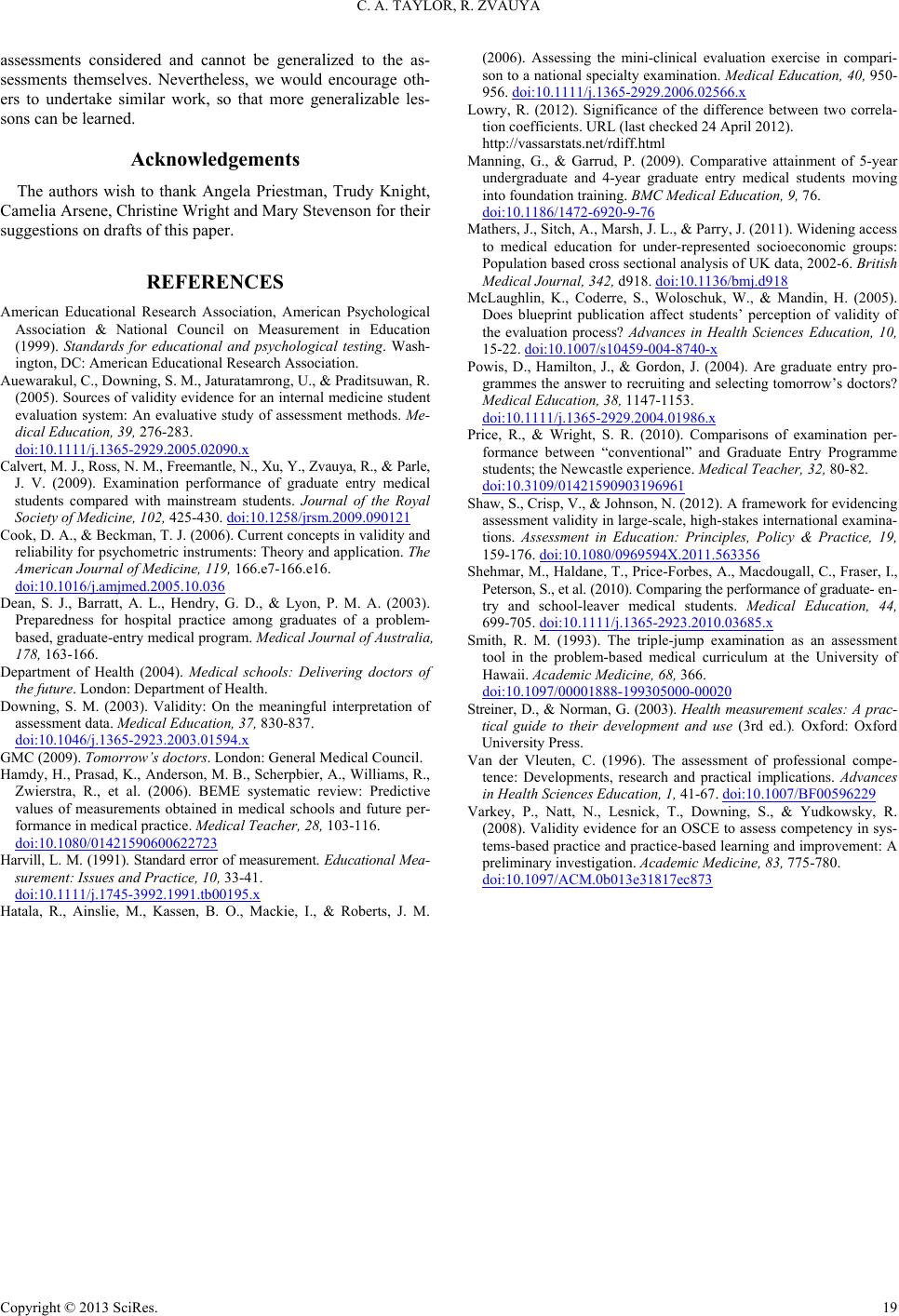
C. A. TAYLOR, R. ZVAUYA
assessments considered and cannot be generalized to the as-
sessments themselves. Nevertheless, we would encourage oth-
ers to undertake similar work, so that more generalizable les-
sons can be learned.
Acknowledgements
The authors wish to thank Angela Priestman, Trudy Knight,
Camelia Arsene, Christine Wright and Mary Stevenson for their
suggestions on drafts of this paper.
REFERENCES
American Educational Research Association, American Psychological
Association & National Council on Measurement in Education
(1999). Standards for educational and psychological testing. Wash-
ington, DC: American Educational Research Association.
Auewarakul, C., Downing, S. M., Jaturatamrong, U., & Praditsuwan, R.
(2005). Sources of validity evidence for an internal medicine student
evaluation system: An evaluative study of assessment methods. Me-
dical Education, 39, 276-283.
doi:10.1111/j.1365-2929.2005.02090.x
Calvert, M. J., Ross, N. M., Freemantle, N., Xu, Y., Zvauya, R., & Parle,
J. V. (2009). Examination performance of graduate entry medical
students compared with mainstream students. Journal of the Royal
Society of Medicine, 102, 425-430. doi:10.1258/jrsm.2009.090121
Cook, D. A., & Beckman, T. J. (2006). Current concepts in validity and
reliability for psychometric instruments: Theory and application. The
American Journal of Medicine, 119, 166.e7-166.e16.
doi:10.1016/j.amjmed.2005.10.036
Dean, S. J., Barratt, A. L., Hendry, G. D., & Lyon, P. M. A. (2003).
Preparedness for hospital practice among graduates of a problem-
based, graduate-entry medical program. Medical Journal of Australia,
178, 163-166.
Department of Health (2004). Medical schools: Delivering doctors of
the future. London: Department of Health.
Downing, S. M. (2003). Validity: On the meaningful interpretation of
assessment data. Medical Educati on, 37, 830-837.
doi:10.1046/j.1365-2923.2003.01594.x
GMC (2009). Tomorrow’s doctors. London: General Medical Council.
Hamdy, H., Prasad, K., Anderson, M. B., Scherpbier, A., Williams, R.,
Zwierstra, R., et al. (2006). BEME systematic review: Predictive
values of measurements obtained in medical schools and future per-
formance in medical practice. Medical Teacher, 28, 103-116.
doi:10.1080/01421590600622723
Harvill, L. M. (1991). Standard error of measurement. Educationa l Mea-
surement: Issues and Prac t i ce , 10, 33-41.
doi:10.1111/j.1745-3992.1991.tb00195.x
Hatala, R., Ainslie, M., Kassen, B. O., Mackie, I., & Roberts, J. M.
(2006). Assessing the mini-clinical evaluation exercise in compari-
son to a national specialty examination. Medical Education, 40, 950-
956. doi:10.1111/j.1365-2929.2006.02566.x
Lowry, R. (2012). Significance of the difference between two correla-
tion coefficients. URL (last checked 24 April 2012).
http://vassarstats.net/rdiff.html
Manning, G., & Garrud, P. (2009). Comparative attainment of 5-year
undergraduate and 4-year graduate entry medical students moving
into foundation training. BMC Medical Education, 9, 76.
doi:10.1186/1472-6920-9-76
Mathers, J., Sitch, A., Marsh, J. L., & Parry, J. (2011). Widening access
to medical education for under-represented socioeconomic groups:
Population based cross sectional analysis of UK data, 2002-6. British
Medical Journal, 342, d918. doi:10.1136/bmj.d918
McLaughlin, K., Coderre, S., Woloschuk, W., & Mandin, H. (2005).
Does blueprint publication affect students’ perception of validity of
the evaluation process? Advances in Health Sciences Education, 10,
15-22. doi:10.1007/s10459-004-8740-x
Powis, D., Hamilton, J., & Gordon, J. (2004). Are graduate entry pro-
grammes the answer to recruiting and selecting tomorrow’s doctors?
Medical Education, 38, 1147-1153.
doi:10.1111/j.1365-2929.2004.01986.x
Price, R., & Wright, S. R. (2010). Comparisons of examination per-
formance between “conventional” and Graduate Entry Programme
students; the Newcastle experience. Medical Teacher, 32, 80-82.
doi:10.3109/01421590903196961
Shaw, S., Crisp, V., & Johnson, N. (2012). A framework for evidencing
assessment validity in large-scale, high-stakes international examina-
tions. Assessment in Education: Principles, Policy & Practice, 19,
159-176. doi:10.1080/0969594X.2011.563356
Shehmar, M., Haldane, T., Price-Forbes, A., Macdougall, C., Fraser, I.,
Peterson, S., et al. (2010). Comparing the performance of graduate- en-
try and school-leaver medical students. Medical Education, 44,
699-705. doi:10.1111/j.1365-2923.2010.03685.x
Smith, R. M. (1993). The triple-jump examination as an assessment
tool in the problem-based medical curriculum at the University of
Hawaii. Academic Medicine, 68, 366.
doi:10.1097/00001888-199305000-00020
Streiner, D., & Norman, G. (2003). Health measurement scales: A prac-
tical guide to their development and use (3rd ed.). Oxford: Oxford
University Press.
Van der Vleuten, C. (1996). The assessment of professional compe-
tence: Developments, research and practical implications. Advances
in Health Sciences Education, 1 , 41-67. doi:10.1007/BF00596229
Varkey, P., Natt, N., Lesnick, T., Downing, S., & Yudkowsky, R.
(2008). Validity evidence for an OSCE to assess competency in sys-
tems-based practice and practice-based learning and improvement: A
preliminary investigation. Academic Medicine, 83, 775-780.
doi:10.1097/ACM.0b013e31817ec873
Copyright © 2013 SciRes. 19